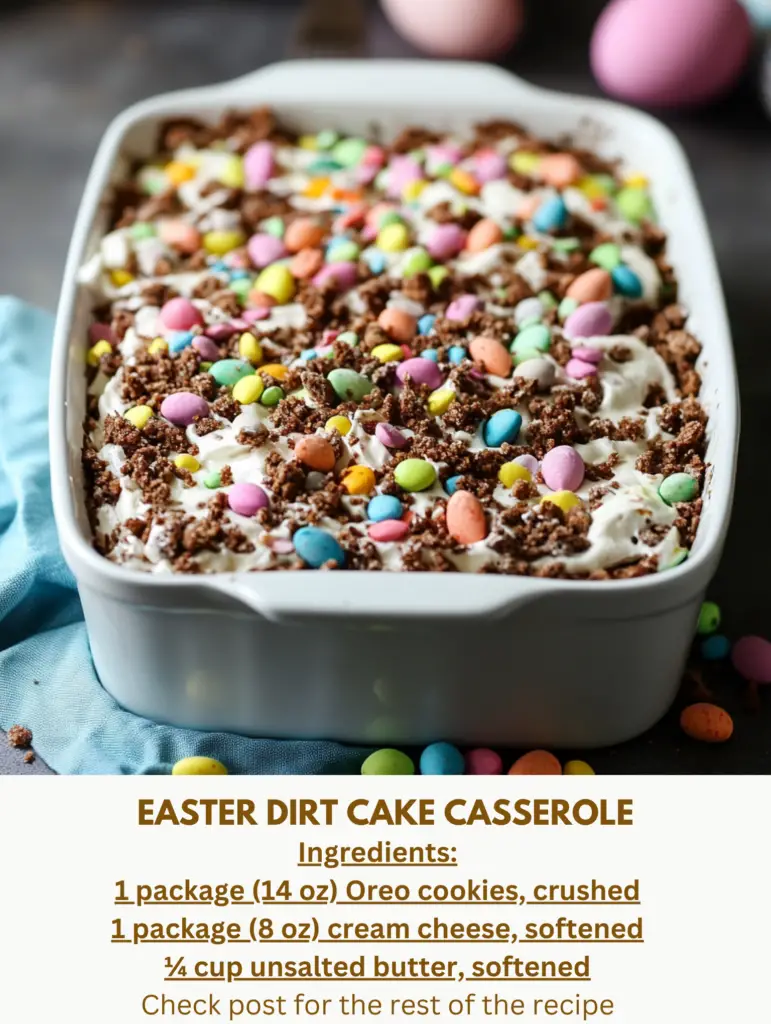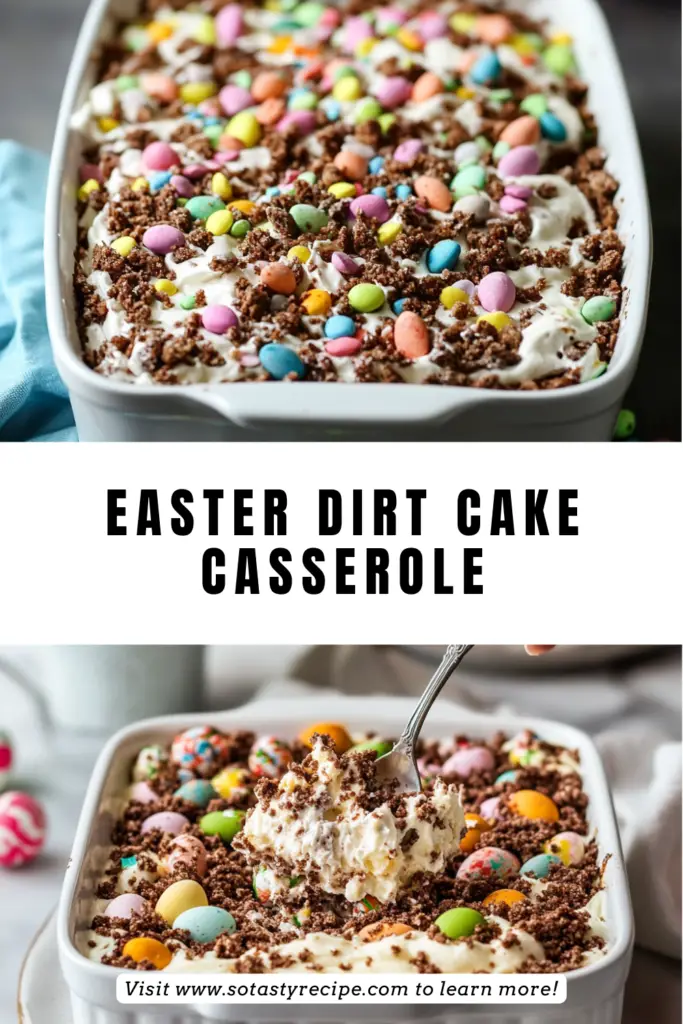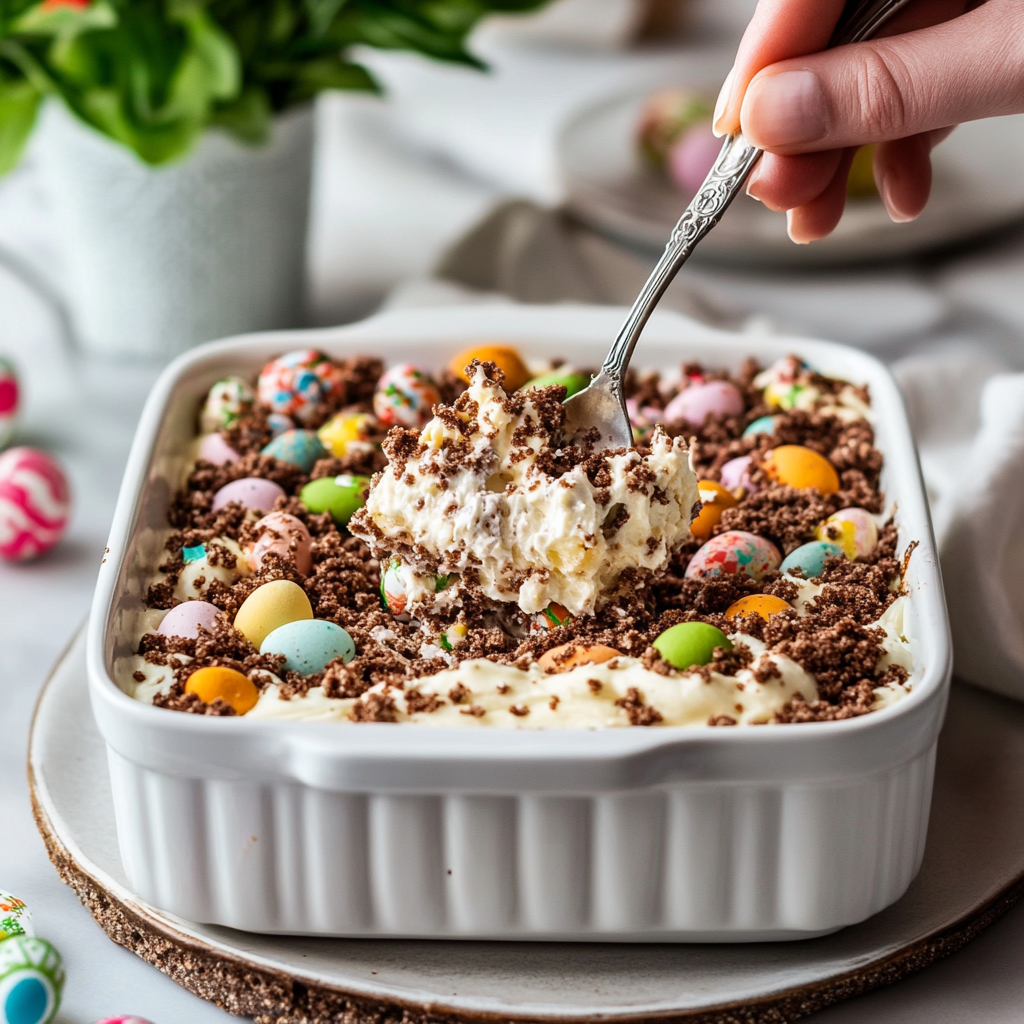Looking for a festive and easy-to-make dessert this Easter? Try this Easter Dirt Cake Casserole! It’s a no-bake, kid-friendly treat that combines creamy layers with a playful “dirt” topping.
What is Easter Dirt Cake Casserole?
Easter Dirt Cake Casserole is a delightful dessert that mimics the look of a garden bed. It features layers of creamy pudding, whipped topping, and crumbled cookies, topped with colorful candy or edible decorations to resemble Easter-themed “dirt.” This dessert is perfect for holiday gatherings, potlucks, or family celebrations.
The Origin and History of Dirt Cake
Dirt cake, also known as worm dirt cake, originated in the United States during the 1980s. It became popular for its whimsical appearance and simple preparation. The dessert often includes gummy worms to enhance the “dirt” theme, making it a hit at children’s parties. Over time, creative variations like the Easter Dirt Cake Casserole emerged, incorporating seasonal elements like pastel candies or chocolate eggs.
Seasonal and Cultural Relevance
Best Season for the Recipe
This dessert is especially popular during spring and Easter celebrations. Its bright, festive appearance makes it a standout addition to holiday tables.
Cultural Relevance
In the U.S., dirt cake is a nostalgic treat often associated with childhood and family gatherings. The Easter Dirt Cake Casserole adds a seasonal twist, making it a staple for Easter brunches or egg hunts.

Key Ingredients
Here’s what you’ll need to make this delicious dessert:
- Oreo cookies: Crushed to create the “dirt” layers.
- Cream cheese: Adds richness to the filling.
- Pudding mix: Vanilla or chocolate, for a creamy texture.
- Whipped topping: Lightens the filling and adds fluffiness.
- Milk: Combines with the pudding mix for a smooth consistency.
- Butter: Binds the cookie crust.
- Easter-themed candies: Such as jelly beans, chocolate eggs, or pastel M&Ms for decoration.
Nutritional Breakdown: While this dessert is indulgent, it provides a fun way to celebrate the holiday. For a healthier twist, consider using sugar-free pudding or low-fat whipped topping.
Preparation Steps
- Crush the Cookies: Use a food processor or rolling pin to crush the Oreos into fine crumbs.
- Prepare the Filling: Mix cream cheese, pudding mix, milk, and whipped topping until smooth.
- Layer the Dessert: Alternate layers of cookie crumbs and filling in a casserole dish.
- Decorate: Top with Easter-themed candies or edible decorations.
- Chill: Refrigerate for at least 2 hours before serving.
Pro Tip: For a firmer texture, freeze the casserole for 30 minutes before serving.
Tools and Techniques
Essential Tools
- Food processor or rolling pin for crushing cookies.
- Mixing bowls and a hand mixer for the filling.
- Casserole dish for layering.
Special Techniques
- Ensure the cream cheese is softened to avoid lumps in the filling.
- Use a piping bag for a more decorative presentation.
Variations and Alternatives
- Gluten-Free: Use gluten-free cookies and pudding mix.
- Vegan: Substitute with dairy-free cream cheese, pudding, and whipped topping.
- Flavor Twists: Try using mint or strawberry pudding for a unique twist.
Pairings and Accompaniments
Serve this dessert with:
- Fresh berries for a refreshing contrast.
- A glass of cold milk or a cup of coffee.
Comparison with Similar Recipes
Unlike traditional cakes, Easter Dirt Cake Casserole requires no baking. Its playful presentation sets it apart from other layered desserts like tiramisu or trifle.
Health and Wellness Aspects
While this dessert is a treat, you can make it healthier by:
- Using sugar-free ingredients.
- Adding fresh fruit as a topping.

Frequently Asked Questions (FAQs)
Where did dirt cake originate?
Dirt cake originated in the United States during the 1980s.
What is another name for dirt cake?
It’s also known as worm dirt cake or mud pie.
What do you need for dirt cake?
You’ll need cookies, pudding mix, cream cheese, whipped topping, and decorations.
What is the Easter dirt dessert?
It’s a seasonal version of dirt cake, often decorated with Easter-themed candies.
Best Time to Enjoy the Recipe
This dessert is perfect for Easter brunches, potlucks, or as a sweet ending to a holiday meal.
Recipe Evolution
Over the years, dirt cake has evolved to include seasonal variations like the Easter Dirt Cake Casserole. Creative bakers have also experimented with flavors and decorations.
Future Vision of the Recipe
As culinary trends shift toward sustainability, future versions of this recipe may incorporate eco-friendly ingredients or plant-based alternatives.
Storage and Leftovers
Store the casserole in the refrigerator for up to 3 days. For longer storage, freeze it in an airtight container.
Presentation Tips
- Use a clear glass dish to showcase the layers.
- Add edible flowers or fresh mint leaves for a pop of color.
Cooking for Specific Needs
- Gluten-Free: Use gluten-free cookies and pudding mix.
- Vegan: Opt for dairy-free alternatives.
Fun Facts and Trivia
- The first dirt cakes were often served in flower pots for added realism.
- Gummy worms became a popular addition in the 1990s.
Personalization and Storytelling
Encourage your family to help decorate the casserole. Share stories of past Easter celebrations while preparing this fun dessert.
Suggested Recipes
For more savory recipes, you can also check my friend Alicia’s blog here.
